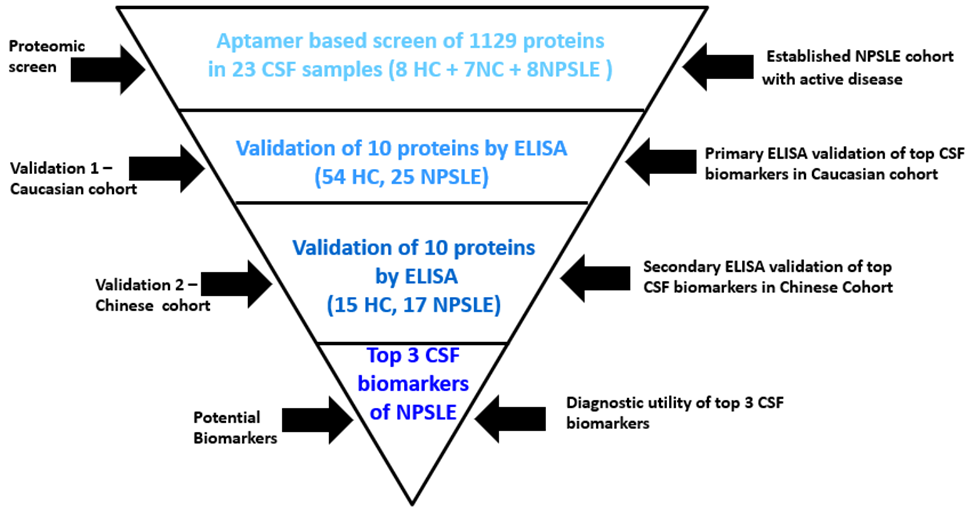
Novel Cerebrospinal Fluid Biomarkers of Neuropsychiatric SLE identified using targeted proteomics
Lead: Kamala Vanarsa
Team Members: Prashanth Sasidharan, Sirisha Gokaraju, Malavika Nidhi
Collaborator: Drs. Hanly and Mok
Project Summary: Clinical diagnosis of Neuropsychiatric SLE (NPSLE) is challenging due to lack of optimized diagnostic approaches and hence there is a need for better, non-invasive biomarkers that help with diagnosis and disease prognostication. We performed an aptamer-based screen of CSF samples for 1129 proteins for the identification of novel biomarkers associated with NPSLE. 26 top performing proteins were identified from the initial aptamer-based assay, from which 10 proteins were selected for ELISA validation in two distinct NPSLE cohorts, Caucasian and Chinese. The best performing biomarkers were subjected to ROC curve analysis. Findings from ELISA validation and ROC curve analysis helped identify several proteins as being associated with NPSLE.
What is already known in the field?
- Neuropsychiatric systemic lupus erythematosus (NPSLE) can present with a wide variety of central nervous system (CNS) and peripheral nervous system (PNS) symptoms and may present in more than 40% of SLE patients.
- Current biomarkers that are associated with NPSLE include serum Antiphospholipid antibodies, Anti Ribosomal P antibodies, Anti NMDA antibodies, Antiganglioside antibodies and antibodies to microtubule associated protein 2.
- CSF IgG index, presence of oligoclonal bands, and anti-neuronal antibodies represent current CSF parameters used in clinical practice.
What is new?
- This study represents the first aptamer-based assay using CSF samples of NPSLE patients.
- The top three CSF biomarkers of NPSLE identified in this work are all novel.
Why is this important?
- NPSLE is a serious, but poorly understood manifestation of SLE, at the mechanistic level. Due to the lack of well-established clinical tests, there is a pressing need to identify novel biomarkers that may be used clinically in the diagnosis and management of NPSLE.
- The biomarkers assessed in the current study serve as potentially useful CSF biomarkers, and may serve as a foundation for future studies that ultimately establish clinically applicable tests for the differential diagnosis of NPSLE.
- The identified CSF proteins also point to potential pathogenic mechanisms that may lead to NPSLE.
Ongoing/future steps:
- These biomarkers may serve as clinically relevant CSF biomarkers, either as diagnostic tests or as potential therapeutic targets in the treatment of NPSLE.
- All three biomarkers identified in this study need to be validated in additional patient cohorts.
- Mechanistic studies are warranted to explore how these proteins might actually cause NPSLE disease manifestations.